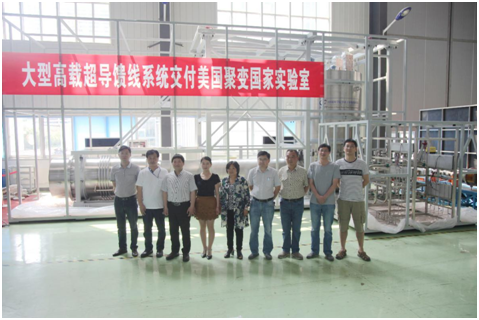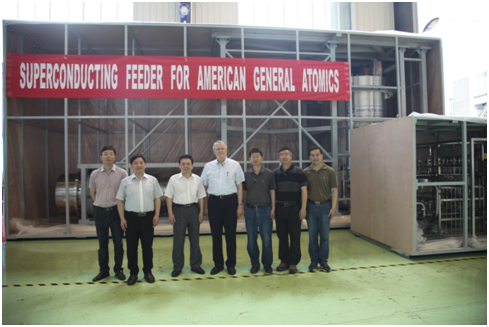
count: [2016-07-14] [Close]
On June 30, 2016, a large superconducting feeder system for US ITER center solenoid coil test was delivered from ASIPP workshop to begin its trip to General Atomics (GA), San Diego, USA.
This feeder system is designed by ASIPP, and supported by three companies of the institute, Juneng, Keye and Keju during the stage of manufacture, assembling, testing and transportation. ASIPP owns the complete intellectual property rights in design, manufacture, assembling and test of the system.
This is another successful example of high-tech cooperation between China and U.S in the field of Fusion Engineering. Dr James Van Dam, Director of Research Division, Fusion Energy Sciences, Office of Science, U.S. Department of Energy (DOE), highly affirmed the significance of this project, and posed in front of the feeder when he visited ASIPP on June 22.
The superconducting feeder system, 10m long, 4.5m high and 25t heavy, consists of a pair of HTSCL (high-temperature superconducting current leads), coil terminal box, cryostat feeder through, busbar and cryogenic pipes. The system will not only provide large current, supercritical helium, measurement and control signal for ITER center solenoid coil test, but also release the coil energy and protect the system in the quench of coil system.
The development of the feeder is far from a piece of cake. The whole project involves the disciplines of mechanical, electromagnetic, cryogenic, vacuum, superconductivity, etc. Through three years' tense effort, the R&D team solves many key technologies: the joint resistance is less than 0.6 n Ω, the quench time is more than 10 minutes, the 15 kV high voltage insulation on the complicated structure on normal and Paschen condition.
At the end of 2015, ASIPP team completed 55 kA current steady running and Loss of Flow Accident test (LOFA). All the parameters meet the design requirements: the lowest temperature of system is less than 5 K, the temperature of thermal shield is less than 90 K, the vacuum is lower than 1e-4 pa, the quench time is more than 10 minutes, the superconducting joint resistance is less than 0.6 n Ω,the heat load to 5 K is about 70W.
During the first half of 2016, the challenge on insulation was overcome, including the insulation wrapping, curing, electric field shielding, voltage measurement, high voltage test and Paschen test of the complicated system. As a result, the insulation performance of the large system is better than the design requirements.
The completion of this project is a early-stage rehersal for ITER superconducting feeder system, said Yuntao Song, deputy director of ASIPP, it will provide technology and experience to guarantee smooth implementation of the ITER feeder procurement package directly. (Quan HAN reports)

Witnessed by Partners

Dr. James Van Dam Visits the System

Ready for Delivery